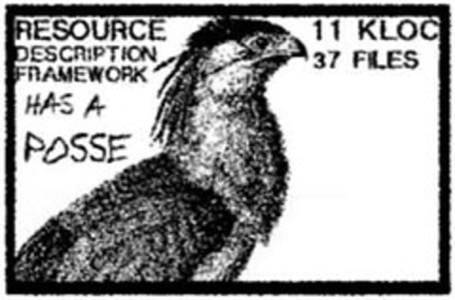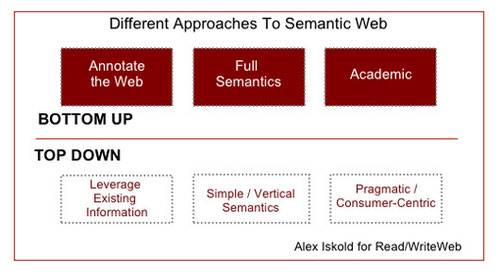RDF is the cornerstone of The Semantic Web, yet there still very few commercial RDF apps.
In the latest issue of Nodalities, a magazine about the Semantic Web by UK company Talis, there is an article by Talis CTO Ian Davis about the state of Semantic Web applications. Davis says that we’re still in “Generation Zero” of the Semantic Web, because there are relatively few compelling apps. Specifically he notes that “there are still only a handful of applications that incorporate RDF at their heart and none of these are using the full potential of the Semantic Web.” RDF is the Semantic Web’s equivalent of the Web’s HTML – its chief characteristic is the ability to ascribe meaning to data.

The few commercial RDF apps that Davis mentions are Twine, a beta knowledge management app and one of the few consumer Semantic Apps on the market today; Davis’ own Talis (it has built a platform and apps such as for library management); and online reputation management tool Garlik. We also know of occasional RWW commenter Kingsley Idehen’s company OpenLink Software, which is building some heavy duty RDF applications.
These can all be considered to be ‘bottom up’ Semantic Web apps. But most Semantic Apps today appear to be ‘top down’.
Bottom Up vs Top Down
To understand the difference let’s return to a classic RWW post by Alex Iskold, who wrote a primer on this topic called Top-Down: A New Approach to the Semantic Web. In that post, Alex Iskold explained that there are two main approaches to Semantic Apps:
1) Bottom Up – involves embedding
semantical annotations (meta-data) right into the data. This is the version that uses RDF extensively.
2) Top down –
relies on analyzing existing information; the ultimate
top-down solution would be a fully blown natural language processor, which is able to
understand text like people do. This rarely uses RDF, because it is seen as too complicated.

Plenty of Semantic Apps – But Most Sans RDF
We’ve noted a lot of ‘top down’ Semantic Apps in recent times. We profiled 10 of them back in November, including Freebase, Powerset, hakia, AdaptiveBlue, TripIt and more.
Startup conferences DEMO and TechCrunch50 both had a raft of Semantic startups vying for attention recently – for example see our review of SemantiFind. We’ve also seen some great advances this year from big companies. Thomson Reuters has been active with its OpenCalais initiative – its latest product SemanticProxy aims to give developers an easier way to extract semantic data from any web site. [Disclosure: OpenCalais is a RWW sponsor] And Yahoo, despite its ongoing struggles, has been showing excellent initative in Semantic Web with products like SearchMonkey – an open developer platform for search.
Talis’ Paul Miller, who runs an excellent ZDNet blog about the Semantic Web, recently referred to a report by David Provost entitled On the cusp: a global review of the Semantic Web industry (PDF). Provost lists 17 apps, only a handful of which mentioned RDF.
It should be noted that Yahoo SearchMonkey does use at least a bit of RDF – RDFa and eRDF according to Provost’s report. As Alex Iskold explained in his SearchMonkey analysis, these are variations of RDF:
“In 2005, Ian Davis, CTO of Semantic Web infrastructure company Talis, proposed eRDF – a form
of RDF that can be embedded into HTML (compatible with HTML4). There is a simple mapping from
eRDF to RDF so you can use any RDF/OWL vocabulary. But eRDF is not full RDF — it has limitations.
For example, there are no data types and there no blank nodes. Also, each page can only “talk” about itself and not about other pages.
Finally, the W3C published RDFa the latest embedding of RDF in XHTML, which
has full RDF support. RDFa adds complexity in terms of implementation, but at the moment, gives the best way to embed RDF into HTML.”
So, Where Are The Commercial RDF Apps?
The title of this post is a genuine question, because this author at least doesn’t know the full answer. We know that Twine, Talis, Garlik and some others use RDF. But where are the other examples? In March, Alex suggested that RDF would be useful in places where interoperability is needed – for example the health community and in enterprises. Let us know in the comments if you know of examples in any of consumer, enterprise, health, or other markets.

Finally, dare we pose this controversial question: has the ‘top down’ Semantic Web “won” and we’ll continue to see far more non-RDF apps in the commercial wild but relatively few RDF ones? Tim Berners-Lee and many other Semantic Web proponents will say a resounding ‘no’ to that. And ok, it will never be that black and white. But let us know your thoughts on whether RDF will become common place in the commercial world any time soon.
Related RWW posts on Semantic Web:
- 11 Things To Know About Semantic Web
- Semantic Web: Difficulties with the Classic Approach
- Top-Down: A New Approach to the Semantic Web
- Semantic Web Patterns: A Guide to Semantic Technologies
Flickr images: ianloic and Peter Morville










